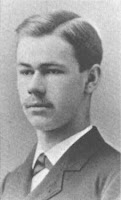
I was interested to learn that it was the U.S. Census that provided the compelling need for the development of the calculating machine, the predecessor of the computer. Herman Hollerith was a young engineer who went to work for the U.S. Census Bureau in 1880. He witnessed firsthand the long and tedious hand tabulation methods used on the 1880 Census data. It took the Census Bureau eight years to finish the tabulations! Hollerith saw the need but nothing came of it immediately.
Hollerith left the Census Bureau for a teaching position at MIT in 1882. He began looking at ways to encode information in punch marks on a continuous paper tape. The needle penetrating through the holes would complete an electric circuit and trigger an electric counter. But the paper tape had too many problems to be practical. On a train ride, Hollerith observed the conductor punching his train ticket. As Harold Ellis relates in They Made America:
The train ticket that Hollerith handed the conductor was also a form of identity card, called a punch photograph, which matched the presenter of the ticket with the purchaser. "The conductor punched out a description of the individual as 'light hair, dark eyes, large nose, etc.' said Hollerith, who then commented on his adaptation of this system to the census: "So you see, I only made a punch photograph of each person."
On January 8, 1889, he was issued U.S. Patent 395,782 , claim 2 of which reads:
The herein-described method of compiling statistics, which consists in recording separate statistical items pertaining to the individual by holes or combinations of holes punched in sheets of electrically non-conducting material, and bearing a specific relation to each other and to a standard, and then counting or tallying such statistical items separately or in combination by means of mechanical counters operated by electro-magnets the circuits through which are controlled by the perforated sheets, substantially as and for the purpose set forth.
Hollerith's invention intrigued the Census Bureau but it did not take it by storm. The Bureau arranged a trial between three competing systems on a limited set of data. Hollerith's machine trounced the other two contenders. The Census Bureau ordered multiple machines, machines that Hollerith had no factory to produce. He contracted his electric tabulators to Western Electric and his punch card machines to Pratt and Whitney. Where it had taken eight years to complete the 1880 Census, it took only one year to complete the tabulations for 1890, even though the population had grown by twenty-five percent.

You might have thought people would have been thrilled. Hollerith's tabulations showed that the United States in 1890 had 62,622,250 people. Some people felt that the numbers were much too low to represent the grand growth they saw everywhere around them. The New York Herald even ran a headline stating:
SLIPSHOD WORK HAS SPOILED THE CENSUS
MISMANAGEMENT THE RULE
Speed Everything, Accuracy Nothing!
Hollerith's calculations stood the test and the he was vindicated. Hollerith's invention found immediate acclaim and for the next 15 years it was used to tabulate census data not only in the U.S. but also in many other countries. But success was not to last. Hollerith charged exorbitant fees to census bureaus to lease his machines. The U.S. Census Bureau balked after the 1900 Census and invented a machine of their own. The competition soon surpassed his devices and his company languished.
In 1912, Hollerith sold the company to the Computer Tabulating Recording Company. This company was created from a variety of lackluster companies in the general field. It continued to languish until Thomas Watson, Sr. took over as the head of sales and marketing. Hollerith was still chief design consultant for the company, but he hated Watson. They hardly ever spoke. Hollerith finally left the company entirely in 1921. The company was renamed the International Business Machine Company (IBM) and the rest, as they say, is history.
No comments:
Post a Comment